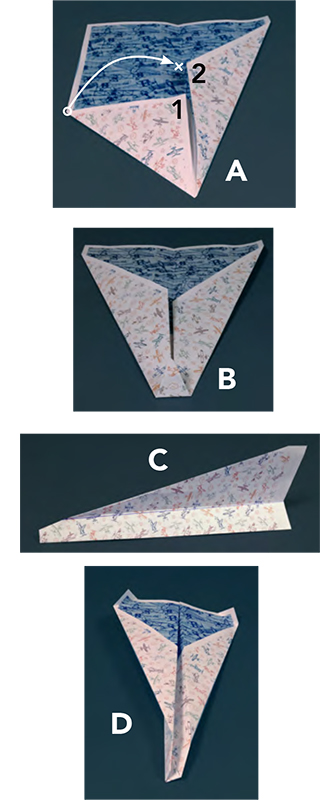Children are fascinated with airplanes. This fascination can be a doorway to rich STEM (science, technology, engineering, and math) learning even for the youngest children.
When outdoors, encourage children to slow down and observe the sky. Look for clouds, birds, and planes. Notice wind speed and direction. Track contrails. Invite children to move their bodies like imaginary airplanes. These can be sources of inspiration for young aviators.
Inventors of early flying machines often were inspired by nature. "The invention of the modern airplane… depended upon the scientific analysis of the anatomy of bird wings and the invention of the internal combustion engine." (Bellis 2015 Gliders) Both Leonardo da Vinci and the Wright brothers hoped to replicate the flight of winged animals like bats and birds. (Leonardo da Vinci Inventions 2008; Bellis 2015 Wright Brothers)
Folded paper airplanes
Folded paper airplanes are "gliders"--aircraft with no power source. Making and playing with paper planes can lead to discussions about aerodynamics (the forces that impact plane flight): thrust, lift, drag, and gravity/weight. Older children can also learn about plane movements like roll, yaw, and pitch. "The most amazing thing about a paper airplane is that all you need to make one is a sheet of paper--nothing more. You don't need scissors, glue, tape, or paper clips. A few folds, a couple of adjustments, and you have a superb paper flyer. The properties of paper give the airplane all the attributes it needs." (Doherty n.d.)
 Older children may enjoy making planes that the youngest children in the program can play with. Young preschoolers may need assistance folding their planes. Toddlers will enjoy chasing after planes thrown by older people and bringing them back for another flight. Allow children to decorate and personalize the paper prior to folding the design. More experienced children can tackle folding designs for specific flight outcomes.
Older children may enjoy making planes that the youngest children in the program can play with. Young preschoolers may need assistance folding their planes. Toddlers will enjoy chasing after planes thrown by older people and bringing them back for another flight. Allow children to decorate and personalize the paper prior to folding the design. More experienced children can tackle folding designs for specific flight outcomes.
- Fold the paper vertically and then open to create a center line.
- Fold the top corners down to meet the center (1). Fold the top corners down a second time to meet the center (2). You now have the wings and nose of the plane. (A)
- Fold the tip of the nose up and back towards the center. (B)
- Fold the wings together, flattening the plane. Draw a line the length of the plane ½"-1" from the bottom. Then fold each wing down along the line, creating the airplane body to grip. (C)
- Create winglets by folding up the back tips of the wings, about a ½" fold. (D)
Time to fly your plane!
(Adapted from: Civil Air Patrol's ACE Program)
Children will have more success if the paper airplane nose is heavier than the tail section. This is usually accomplished with some extra folds. If the nose drops and the plane dives into the ground, bend up the back of the wings. A little bend goes a long way. If the nose rises first and then drops, the plane is stalling. Bend down the back of the wing. (Doherty n.d.)
Making paper airplane fun more STEM-rich
Children experience Newton's laws of motion when they play with homemade airplanes. They realize that no still object will start moving by itself. It needs a push--the harder the push, the farther or faster the flight. A forward moving object will meet with a resisting force. (Doherty n.d.)
To increase the amount of discovery and experimentation, provide several paper airplane design ideas and have children make a variety and compare flight results. Name or number the planes and keep a chart of the distances. Use a long tape measure or skein of yarn to measure distance of flights, and masking tape or craft sticks to mark the end spot of each flight. Conduct several test flights with each plane and average the results. A wide open space like a gym or gross motor play area is a great place to test paper airplanes. Choose a day with no wind for the most satisfying outdoor testing.
Where to find other design ideas
Public and school libraries often have books on paper airplane folding. The following websites also provide many options for children to explore:
- Alex's paper airplanes
- Amazing Paper Airplanes (also has video clips of real planes that align with the paper plane designs!)
- Science Buddies (contains more information on how paper airplanes work.)
References
-
About.com Inventors. 2015. "The Dynamics of Airplane Flight." About.com.
-
Bellis, Mary. 2015. "Conquest of the Air - Introducing The Wright Brothers." About.com.
-
Bellis, Mary. 2015. "The Conquest of the Air - Gliders." About.com.
-
Civil Air Patrol's Ace Program. 2011. "Paper Airplanes, Grade 4 Academic Lesson #3." Civil Air Patrol. Civil Air Patrol. Educators page.
-
Doherty, Paul. (n.d.) "Paper Airplanes." Exploratorium 23(2).
-
Leonardo da Vinci Inventions. 2008. "Flying Machine." Leonardo da Vinci Inventions.
-
Science Buddies. 2014. "How Far Will It Fly? Build & Test Paper Planes with Different Drag." Science Buddies.

